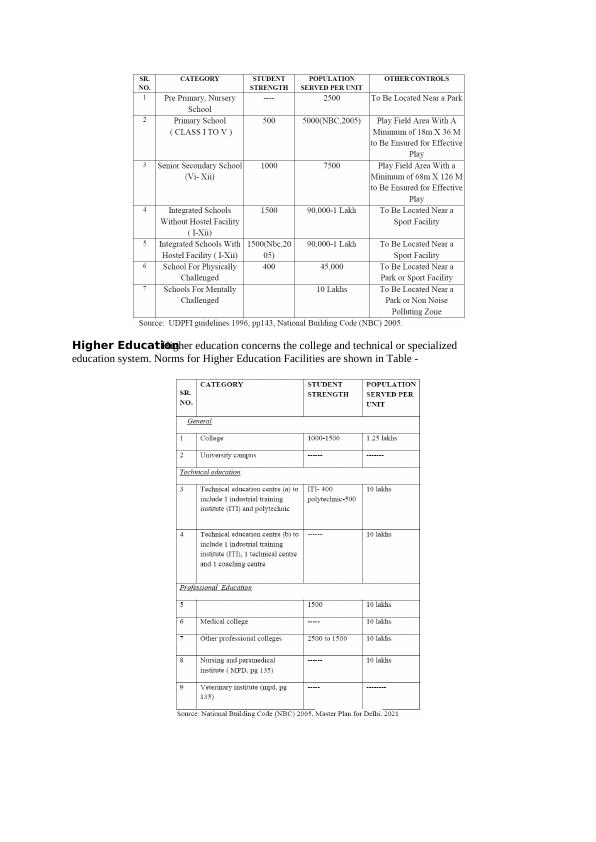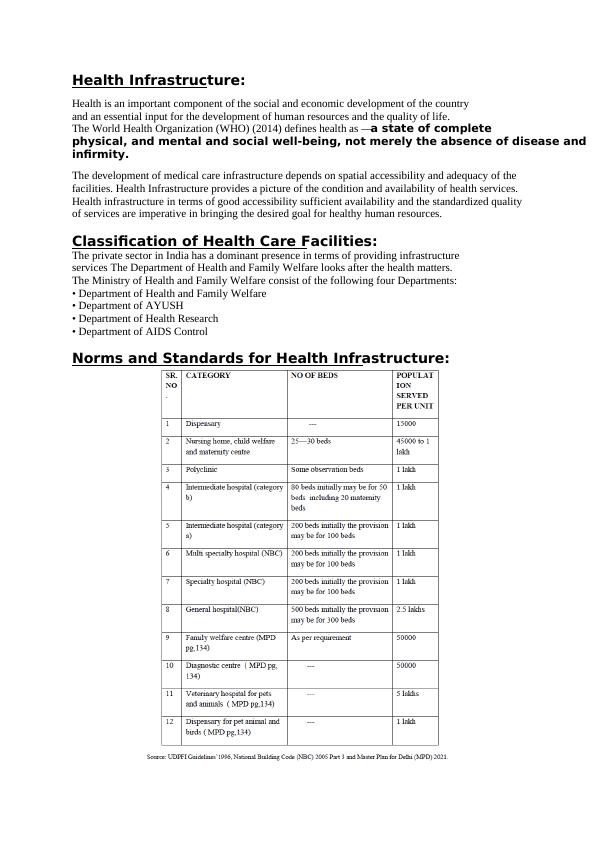Ask a question from expert
Infrastructure is fundamental to economic development Assignment
12 Pages2068 Words319 Views
Added on 2021-06-30
Infrastructure is fundamental to economic development Assignment
Added on 2021-06-30
BookmarkShareRelated Documents
SOCIAL INFRASTRUCTURE STANDARDS AND COMMERCIAL FACILITIES BY JASNEET SINGH NARU Infrastructure: Infrastructure is fundamental to economic development and plays a vital role in shaping the quality of life of individuals and societies. “Development in infrastructure brings out a strong positive relationship between level of GDP and infrastructure stock per capita, one percent increase in stock of infrastructure is associated with one percent increase in GDP across all countries” (World Bank Development report 1994) Definition of Infrastructure: According to the Planning Commission Government of India ‘Infrastructure is recognized as a crucial input for economic development, but there is no clear definition of infrastructure has been given according to the current usage in India. Ministry of Finance, Department of Economic Affairs, defined ―Infrastructure‖ as an essential input to the economic system. Classification of Infrastructure: According to theurban development plan formulation and implementation (UDPFI) Guidelines (1996)infrastructure is the basic requirement of urban life and its adequacy and accessibility are two important ingredients and key contributors in the up gradation and enrichment of quality of urban life which is the primary objective of any planned development effort. UDPFI Guidelines has classified infrastructure as: Physical infrastructure: includes a) Water supply, b) Sewerage, c) Drainage d) electricity and e) solid waste. Social infrastructure: includes a) Education facilities b) Healthcare facilities c) Socio Cultural facilities d) Recreational facilities e) Sports Facilities f) communication facilities g) Distribution Services health h) Police Safety. Commercial facilities covering: a) CBD, b) Sub-city Business District, c) District Centre Recreational Facilities: covering: a) Parks and Open Spaces, b) Sports Centre and Play Grounds c) Botanical and Zoological Parks d) Water Bodies/Other Natural Features, and e) Places of Tourist Interest Traffic and Transportation DEFINITION OF SOCIAL INFRASTRUCTURE World Bank report (2004)defined Social infrastructure as the infrastructure that promotes the health, education and cultural standards of the population, activities that have both direct and indirect impact on the welfare and included schools, libraries, universities, clinics, hospitals, courts, museums, theatres, playgrounds, parks, fountains and statues in it. SocialInfrastructure Assets ▪Health:Medical centers and facilities, Drinking Water and wastewater treatment sanitation ▪Education:Schools (primary and secondary), colleges training facilities Tertiary facilities, Residential student accommodation ▪Housing:Residential, State or Council and Defense force housing ▪Recreation: Community and sports facilities, Parks and rides, markets and cinema hall, public library ▪Civic and Utilities:Bus stations, street lights

▪Law and order:Prisons, Court houses, police check posts They have considered social infrastructure in relation to other infrastructure in the following manner: ▪Social and cultural infrastructure: Health and mental health care, Education and learning, Social services and support, Arts and culture, Recreation – parks, open space, Civic services, local government, Spiritual – places of assembly etc. ▪Economic infrastructure: Finance systems, Businesses, Retail and manufacturing, Trade, Transport systems and networks, Telecommunications, Agriculture ▪Physical infrastructure: Road, ports, ▪Environmental: Waste water, Storm water, Irrigation, Flood control, Sewage, Solid waste disposal, Air quality control. EDUCATION Schooling in India has sis to historically been privately provided where in teachers, who also had religious or spiritual preoccupation, formally imparted education .Despite this, access to some basic schooling was available to both the rich and the poor .while access to education was perhaps not entirely egalitarian or wide spread, the poorest could obtain some initial schooling for their children in an area when state subsidies were largely absent , large masses of the population have remained outside the orbit of the benefits from the public education system in India. Educational deprivation has two dimensions: • lack of schools and poor infrastructure and • poor quality of teaching There has been a greater policy emphasis on the provision of more schools (quantity) than on activities that actually take place side class rooms (quality) At the elementary level universal access to quality infrastructure and effectiveness of teaching are serious challenges (Agarwas 2001). Many schools lack access to basic amenities. As of 2002, 1693 primary schools have no school building (NCERT, 2002). The 73rd and 74th constitutional Amendments underlined the role to be played by local bodies both in rural and urban areas with respect to provision and governance of education promotion of cultural, education and aesthetic aspects. Norms for Education Facilities: Pre-primary to Secondary Education: Pre-primary education is usually meant for children below 6 years of age to prepare the children for admission to primary schools at the age of 6 years. At the next level Primary education is imparted to children between 6 and 10 years of age studying in classes from Class-I to Class-IV/V. The UDPFI guidelines have mentioned guidelines for the education institutions. The norms for Pre-Primary to Secondary Education shown in Table-2.1. The Secondary and Higher Secondary (HS) levels include education from Class VI to Class X and from Class XI to XII.

Higher Education: Higher education concerns the college and technical or specialized education system. Norms for Higher Education Facilities are shown in Table -

Health Infrastructure: Health is an important component of the social and economic development of the country and an essential input for the development of human resources and the quality of life. The World Health Organization (WHO) (2014) defines health as ―a state of complete physical, and mental and social well-being, not merely the absence of disease and infirmity. The development of medical care infrastructure depends on spatial accessibility and adequacy of the facilities. Health Infrastructure provides a picture of the condition and availability of health services. Health infrastructure in terms of good accessibility sufficient availability and the standardized quality of services are imperative in bringing the desired goal for healthy human resources.Classification of Health Care Facilities: The private sector in India has a dominant presence in terms of providing infrastructure services The Department of Health and Family Welfare looks after the health matters. The Ministry of Health and Family Welfare consist of the following four Departments: • Department of Health and Family Welfare • Department of AYUSH • Department of Health Research • Department of AIDS Control Norms and Standards for Health Infrastructure:

End of preview
Want to access all the pages? Upload your documents or become a member.
Related Documents
Sociology Essay 2022lg...
|8
|1888
|14
Factors Affecting Aboriginal Community Healthlg...
|4
|651
|77